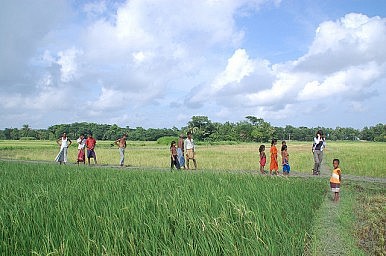Issues with water resource management in Bangladesh have some very broad repercussions.
In recent decades, Bangladesh has made remarkable progress in supplying safe water to its citizens, yet serious disparities in coverage persist across both rural and urban areas. Although the government has numerous water initiatives underway, it has never properly addressed the social vulnerabilities of women and children in rural villages that can be linked to water stress.
According to UNICEF, 97 percent of Bangladeshis have access to tube well water. This has dramatically reduced the incidence of water-borne diseases such as diarrhea and cholera. But instead of developing modern water supply facilities to utilize surface water across the country, the focus of water management has shifted to heavy engineering development for flood control, river erosion control, and irrigation system installation. The relative inattention to household needs has had serious consequences, especially for Bangladesh’s huge rural population.
Exacerbating the problem are the recent industrial boom, rapid urbanization, extensive agrochemical use, and inadequate sewage systems. Each day about 2 million tons of untreated waste are dumped into rivers and their distributaries. Studies shows that just one liter of waste is sufficient to pollute eight liters of fresh water.
Bangladesh gets fully 92 percent of its water from rivers originating mostly in India and China, with just 8 percent coming from local rainfall. The volume of water reaching Bangladesh is also under pressure from the enormous populations of India and China, with upstream construction heavily limiting the flow of water downstream into Bangladesh. This is not only constraining surface water availability, it is also significantly reducing the volume of groundwater in many parts of the country.
Water shortages are a problem shared by both rural and urban areas. The water supply in major cities is the responsibility of city authorities, but in rural areas that authority is missing. Some families install their own supply system but others depend on a common tube well. This haphazard management of water exposes the whole nation to serious health risks.
Demand for water in the capital Dhaka is 2.2 billion liters a day, while production is 1.9 billion liters a day. Chittagong, the second largest city, supplies 210 million liters each day against demand for 500 million liters. The water that is available is often reported to be dirty, odorous or contaminated. Tap water is not suitable for drinking, and public health authorities urge people to boil the water properly before using it. This in turn puts pressure on the country’s already struggling natural gas supply. During a hot summer, the water shortage becomes unbearable for many.
Health authorities have meanwhile assured the public that tube well water is safe. But in the 1990s groundwater in Bangladesh was found to be toxic with high levels of arsenic. An estimated 77 to 95 million people drink groundwater that contains arsenic levels well above the safe limit. This toxic element is not only causing disease, it even has implications for social lives. Because of the lesions and gangrene it causes, people are not welcomed at public gatherings, children cannot go to school, and young adults cannot marry. The health risks of arsenic are well documented but the social implications have yet to be addressed.
The problem is especially acute in the northern districts, which often suffer from severe drought. This is especially hard on women, as they are in charge of water for household use in Bangladesh. Rural women come under under enormous pressure and water scarcity is often a cause of domestic violence.
Even in coastal areas where water is supposedly more available, women must often make several trips to fetch water from distant sources. Increased salinity has added a new vulnerability to already marginalized and disaster-prone coastal societies.
In the remote village of Bagerhat in Southern part of the country, water scarcity has had serious repercussions for marriage. Parents are not interested in matches that would send their children to villages where water is scarce. Moreover, the skins of young women are reported to have roughened because of the increased salinity of available water from nearby sources.
In an interview conducted by CARE, Padmabala Mondol (45) from Fultola in Shyamnagar Upazila said, “No decent parent wants their daughter to marry a boy from such communities because their daughter has to travel great distances to get water, so marriages are taking place mostly among villagers.”
Water problems stem mostly from an over-dependence on groundwater. Experts estimate that over the last decade groundwater has been declining at a rate of three meters per year. Rapid urbanization and industrialization are often regarded as achievements for Bangladesh. But this rapid, unplanned development has also created an acute electricity crisis across the country that has disrupted water production and supply. If the current rate of urbanization continues and the government fails to take adequate steps, the future looks grim.
It is a daunting task to ensure sufficient, safe water for every single member of such a large population. With assistance from the World Bank, the Japan International Cooperation Agency, and myriad other NGOs, Bangladesh has made considerable progress in tackling the water crisis, and improving health and sanitation. However, isolated examples of success will only place more pressure on other sectors. Without a more socially inclusive water policy, this positive trajectory will not be sustainable.
Source: The Diplomat










